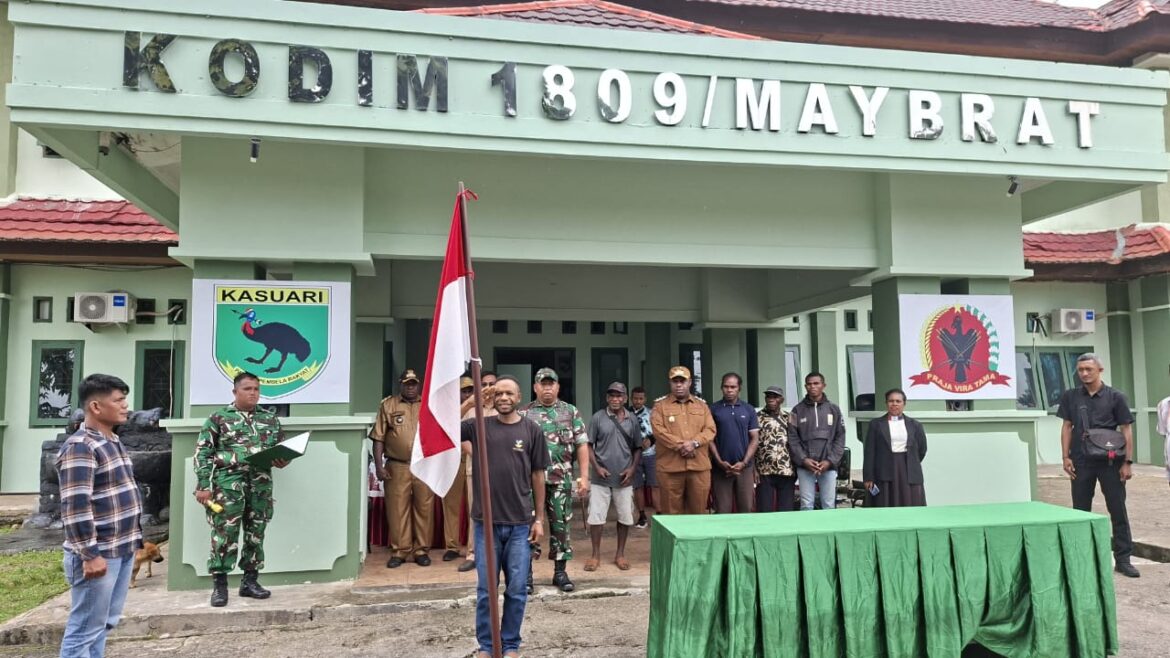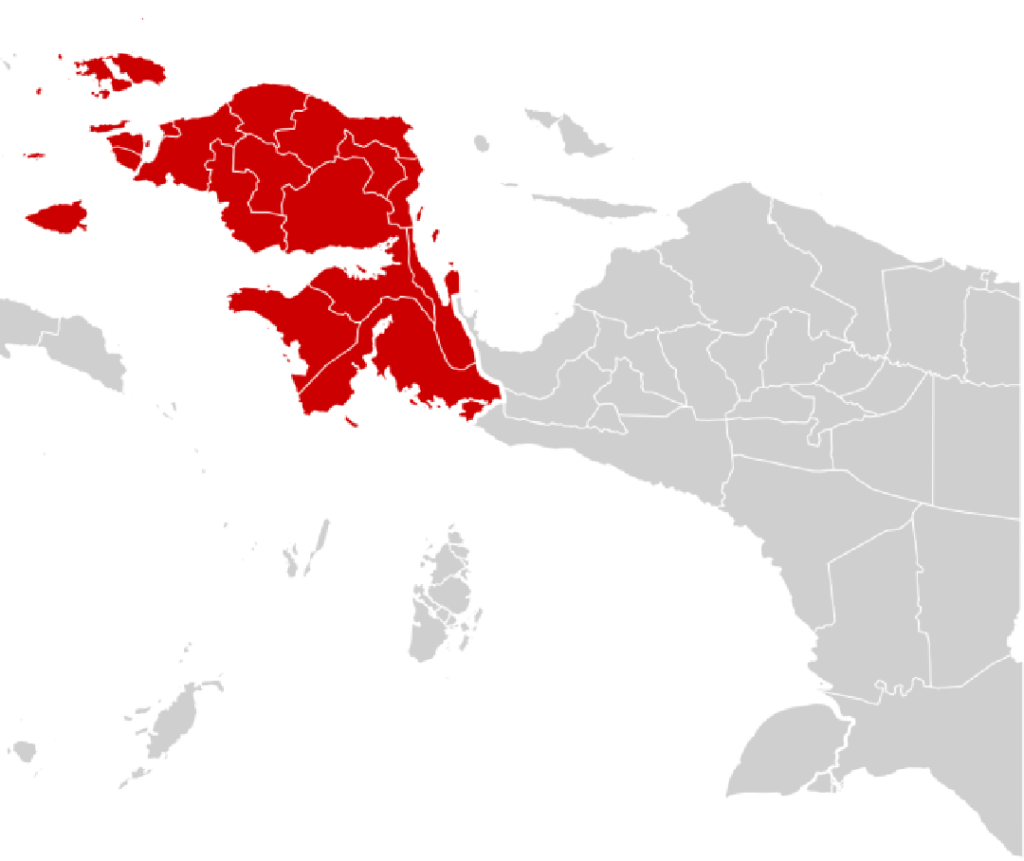In the remote highlands and coastal plains of West Papua, a quiet but profound transformation is underway. On 8 September 2025, at Mefkanjim II Village, Ayamaru District, Maybrat Regency, Papua Barat Daya (Southwest Papua) Province witnessed a historic event: several former leaders and sympathizers of the Free Papua Organization (OPM) publicly renounced armed struggle and separatist ideology, pledging their unwavering loyalty to the Unitary State of the Republic of Indonesia (NKRI). The “Ikrar Setia NKRI”—Pledge of Allegiance to the NKRI—was more than a symbolic act; it was a public acknowledgment of past mistakes, a testament to personal courage, and a bold step toward reconciliation in a region long marred by conflict.
The ceremony, held at Military District Command (Kodim) 1809 Maybrat, brought together a cross-section of society: military officers, local government officials, church leaders, elders, families, and members of the broader community. Two prominent figures, Hendrik Kawen (38 yo), formerly Deputy Commander of the West Papua National Liberation Army (TPNPB) from Battalion IV/Karef Hamid Sorong Raya, and Ekolandos Sakof (27 yo), previously a West Papua National Committee (KNPB) leader in Siwa, stood before the assembly to voice their commitment to Indonesia. Their presence underscored the growing momentum of reintegration efforts, signaling a new chapter for both former combatants and the communities they once disrupted.
The Human Face of Reconciliation
These pledges are not mere formalities. They carry the weight of personal histories steeped in hardship, fear, and the consequences of armed struggle. Individuals like Hendrik Kawen, once vice‑commander of Battalion IV Sorong Raya, had lived in the shadows for years, involved in covert operations and raids that left scars on both sides of the conflict. Ekolandos Sakof, 27, led protests under the banner of the KNPB, challenging local and national authorities alike. Their decision to pledge allegiance was deeply personal: an acceptance of past misdeeds, a desire to rebuild trust, and a vision for a peaceful life for themselves and their families.
For communities in Maybrat, these pledges represented hope. They signaled that the cycle of fear and retaliation could be broken, that former rebels could return as constructive citizens, and that loyalty to NKRI was compatible with local Papuan identity. As one local elder remarked during the ceremony, “This is a moment for healing—not just for the returnees, but for the entire community. It shows that reconciliation is possible, even after years of conflict.”
Historical Context of Papua’s Struggle
Papua’s separatist movement is rooted in a complex web of history, identity, and grievance. The OPM, advocating for independence, has for decades conducted armed campaigns in remote areas, sometimes supported by local sympathizers, and often clashing with Indonesian security forces. These conflicts have brought suffering to ordinary civilians, disrupted local economies, and perpetuated cycles of mistrust between the state and communities.
However, the recent pledges reveal a nuanced reality: support for separatism is not monolithic. Many former OPM members cite personal, rather than purely ideological, reasons for their initial involvement—family pressure, limited economic opportunities, and a sense of disenfranchisement. Their return to the fold of NKRI reflects both a personal reckoning and an evolving strategy by local and national authorities to promote dialogue, reintegration, and community-driven reconciliation.
The Ceremony: A Narrative of Transformation
At Kodim 1809, the atmosphere was charged with emotion. Former fighters and sympathizers stood solemnly, hands raised, as they recited the Ikrar Setia NKRI. The pledge itself was straightforward but profound: an acknowledgment of past wrongdoing, a commitment to cease all forms of armed struggle, and a vow to contribute positively to society under the unity of Indonesia.
Military officials, including Letkol Inf Afrianto Doly, commander of Kodim 1809, emphasized the state’s commitment to support reintegration. “These individuals are not enemies anymore. We will provide assistance in education, livelihoods, and community development. This is a collective effort for peace,” he stated. Local government officials echoed this sentiment, highlighting the importance of societal acceptance alongside formal pledges.
Family members, often long fearful for the safety of their relatives involved in separatist activities, were visibly relieved. Tears mingled with smiles as fathers, mothers, and siblings embraced their returning kin, welcoming them not just physically but morally back into the fold of the community. The collective sentiment was clear: peace is a shared responsibility, and reintegration is both a personal and communal journey.
Personal Reflections of Former OPM Members
Hendrik Kawen spoke candidly about his experiences: the fear, the isolation, and the moral conflicts that accompanied years in the movement. “I regret my actions,” he admitted. “I was led by anger and ideology, but I now see that violence only brings suffering. I want to rebuild my life and help my community, not harm it.” Similarly, Ekolandos Sakof expressed a desire for normalcy: access to education, stable employment, and the ability to raise a family without fear of conflict.
Hendrik Kawen and Ekolandos Sakof highlighted the importance of community support in their decisions. Without the guidance of local leaders, church figures, and mediators, they admitted, returning would have seemed impossible. Their statements reinforced a central theme: reconciliation is not solely a top-down process but a networked endeavor requiring trust, dialogue, and tangible support systems.
Implications for Peace and Governance
These pledges hold broader implications for Papua and Indonesia as a whole. Firstly, they demonstrate that armed separatism is not an immutable condition. Individuals and communities can transition from conflict to civic participation when given proper guidance and support. This dynamic can serve as a model for other districts where OPM presence remains strong, illustrating that dialogue, community engagement, and reintegration programs can yield measurable results.
Secondly, the pledges enhance the legitimacy of government outreach efforts. By publicizing these oaths of loyalty, the state signals a willingness to forgive and integrate, rather than punish exclusively. This can encourage other former militants or sympathizers to follow suit, potentially reducing the operational capacity of separatist groups and fostering regional stability.
Finally, these events underscore the intersection of identity, loyalty, and civic responsibility. By embracing NKRI while retaining Papuan cultural identity, former combatants illustrate that national and local allegiances are not mutually exclusive. This narrative can strengthen social cohesion, reduce ethnic or ideological polarization, and support the development of inclusive governance structures in Papua.
Potential Challenges
Despite the optimism, challenges remain. OPM hardliners may view returning members as traitors, risking internal reprisals or social ostracization. Communities themselves may harbour skepticism, questioning the sincerity of pledges and requiring sustained demonstrations of good faith. Moreover, symbolic pledges must be reinforced by concrete policies: access to education, healthcare, economic opportunities, and security assurances are critical to ensuring that reintegration is sustainable.
Without these supports, there is a risk that pledges may be symbolic only, potentially eroding trust if expectations are unmet. Therefore, the state’s role in providing consistent, visible, and meaningful support cannot be understated.
The Way Forward
Looking ahead, the Ikrar Setia NKRI in Maybrat represents a starting point rather than an endpoint. Continued engagement, community-based reconciliation programs, and investment in livelihoods are essential. Authorities must prioritize both security and development, ensuring that returning individuals can participate fully in civic life without fear or stigma.
Equally important is the narrative: these pledges are stories of courage, transformation, and hope. By amplifying these stories, media, civil society, and government institutions can reinforce the message that peace is possible, that loyalty can coexist with local identity, and that former adversaries can become contributors to a stable, prosperous Papua.
Conclusion
The public pledges of Hendrik Kawen and Ekolandos Sakof mark a pivotal moment in the ongoing journey toward peace in Papua. They show that even those once engaged in armed conflict can choose dialogue, reconciliation, and national loyalty over violence. These oaths are more than words—they are commitments that, if supported by the community and state, could transform both lives and the social fabric of West Papua.
In a region long shadowed by conflict, the Maybrat pledges shine as a beacon of possibility. They remind all stakeholders—government, military, civil society, and ordinary citizens—that peace is not inherited but built, step by step, pledge by pledge. As more former combatants embrace NKRI, a new narrative emerges: one of unity, shared responsibility, and hope for a Papua that thrives within Indonesia while honouring its unique identity.


